By Jil Westcott, Cruising Club of America Boston Station, Narragansett Bay Post
Having sailed Moon Shadow, our 2000 Aerodyne 47, to Lagos, Portugal, in 2019, John and I are eager to return, but COVID-19 intervenes. When can we go? Our reservations change — we have an April 2020 departure, then August 2020, then April 2021, and finally May 6, 2021. Two days before our flight, however, we receive an email from SATA (Azores Airlines) refusing passage. After many efforts to contact an overwhelmed customer service, we speak with Tonya, who says that while our negative PCR tests are acceptable for entry into the Azores, Portugal’s restrictions prevent us from continuing to the mainland. After endless discussion, the Boston station manager authorizes our flight through to Lisbon, though we have to walk out of the terminal at Pointa Delgada Airport and re-enter for the “domestic flight.”
The boat breaks
We meet Ricardo Salgado, our magnificent customer service representative at the Sopromar boatyard, on Saturday morning. Ricardo had called the day of our flight to tell us attempts to run our 2016 Yanmar JH57 engine had failed. Corrosion on the wiring harness caused electrical fittings to break off. He’d already found the replacement part and sourced it with three-day delivery. Now he apologizes for not catching the problem sooner and suggests we can keep our launch date. Have you met a yard that has given you such superb service? As John says, it’s worth sailing hundreds of miles out of our way to leave Moon Shadow in such good hands.
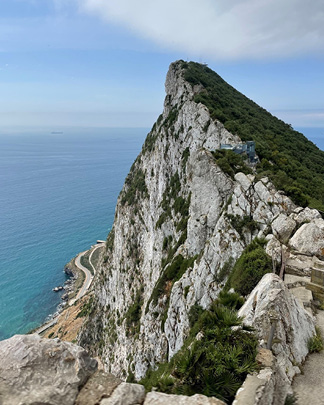
Rock of Gibraltar
Lagos, Portugal
Between boat commissioning chores and provisioning, we slip in a few moments of relaxation at the Praia do Pinhão beach. Moon Shadow has been cleaned inside and out. At the end of our 2019 trip, a vast Sahara sandstorm had turned the sky brown all the way north to Lisbon and covered the boat’s exterior in ultra-fine wet caking sand. Then the carpenter we hired (who was later fired by the boatyard) to recover our galley countertop left sawdust on all visible surfaces — a friend had sent us photos of the sight. Without prompting, Ricardo had sent two cleaning ladies to make the mess disappear before our arrival, a bill we gladly paid. We defer fixing the newly discovered broken jib track and launch on May 18 — the first week Portugal officially permits sailing in and out of the harbors. Back on the water just 12 days after a winter haul-out that became eighteen months.
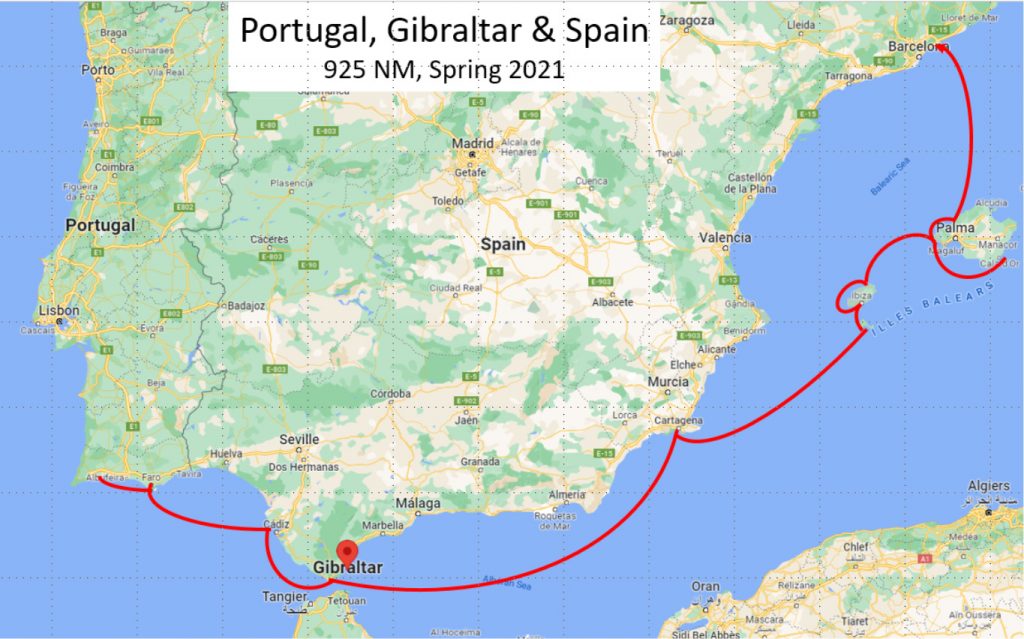
Our travel from May 7 through July 25, 2021
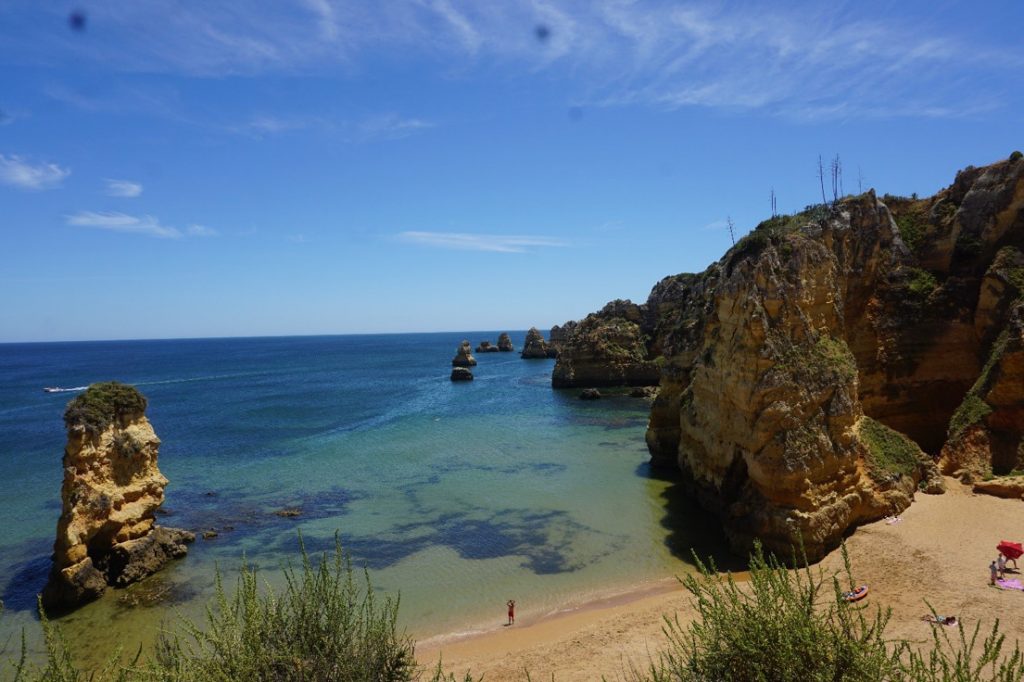
Praia do Pinhão beach, Lagos Portugal
Legalities
Our next challenge is to reset the boat’s VAT tax clock by leaving the EU for one night. Customs officials stopped working during COVID’s peak and had ignored our efforts to get a legal extension. We’re now exceeding the 18-month limit, and our yard manager suggests we quietly leave town. Morocco, the usual EU reset destination, is closed to all marine traffic due to COVID, so our destination is Gibraltar.
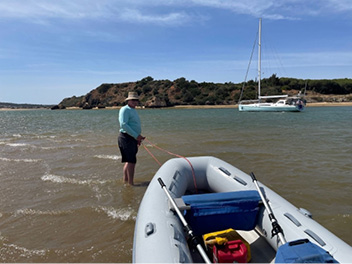
Alvor anchorage
We depart two days later, motoring four miles to Alvor. Our small 2.5 HP Honda outboard runs well on a trip into town until we stop to talk to a surfer. After that, the out- board runs a few seconds and quits. Increasingly frustrated, John eventually rips the starter cord out of the engine. A German launches his dinghy and tows us into town. We have a magnificent lunch, then row our inflatable across a small bay against the wind, walk about a mile along the mudflats, then row downwind 75 yards to get home.
Two days later, we sail on to Faro, a 40-nautical-mile afternoon jaunt that tests our sails. They fly! We remember how to operate the lines. Small miracles. We count on 7 knots and get 8, even with the jib shortened by 2.5 rolls to protect our newly cracked jib track. Taped off and lashed down, the remaining track works well.
The next day, we sail 90 nautical miles to Cadiz, Spain. We don’t want to check in and risk boat VAT questions, so we fly the quarantine flag. It is so windy we defer our start to 10 a.m.’s relative calm. Eventually the wind returns, enabling a reefed Moon Shadow to reach at 8 to 10 knots while surfing down 6-foot waves. Approaching shallow waters off Cadiz at sunset, we average 8.7 knots hand-steering through breaking waves and anchor next to a beautiful bridge in the last of the twilight.
While the anchorage is beautiful, the communications are frustrating. We had promised to call home, but the Portuguese Vodaphone chip will not connect in Spain, contrary to the company’s promises.
Adding to the tension was a VHF distress call we’d heard on our sail to Cadiz. Orcas had attacked a sailing vessel in the Bay of Cadiz. Spain’s maritime rescue service advised stopping the boat, centering the rudder, and turning off all electronics that emit signals into the water, stating that the orcas will lose interest and move away. Ten minutes later, the orcas did leave, and the sailboat was advised to continue on her course. Orca attacks have been on the rise since July 2020 — fifty-six attacks in southwest Spain in 2021, with half the boats requiring towing due to rudder damage. The government created an exclusion zone of 2–9 nautical miles offshore for boats under 50 feet between Cabo de Trafalgar and Punta Paloma during the summer tuna migration season. Northwest Spain had had an exclusion zone earlier. In August 2022, orcas sank a 36-foot sailboat six miles off Sines, Portugal. All five onboard escaped in a life raft.
Attacks are reported throughout the tuna migration area — orca feeding grounds. Biologists currently believe this unusual behavior is mostly from juveniles in two pods. Some believe the attacks are retribution for a poacher’s orca harpoon strikes; others say it’s play.
Strail of Gibraltar
So exciting! With Europe to port and Africa to starboard, passing through the strait on our own boat is a wonderful milestone. Seven miles wide, 3,000-feet deep, and with vast shipping traffic, the strait impresses. At the western end, the Tarifa lighthouse records winds over 30 knots 300 days a year. The strait is an east/west wind tunnel between tall mountains. The wind and a constant 2–3-knot eastward current can create treacherous seas. We can see Africa!
Spanish officialdom in a speedboat tracks us for a number of miles and then bears off. The VHF is full of alerts — prob- lems, people in the water, and so many languages. Spanish is familiar, but Arabic? All emergency traffic is conducted in both Spanish and English.
Birds float by picking on the flesh of enormous dead tuna. The Spanish set out convoluted fish mazes that catch and confuse the tuna, and then they try to kill them by spearing. All sizes of tuna are caught. Some escape to die at sea.
Gibraltar
In lovely Queensway Quay Marina, surrounded by million-dollar condos and high-end restaurants, nothing works quite right. The hosts are kind, but they insist on an on-board quarantine until we pass two COVID PCR tests spaced five days apart. We must pay a king’s ransom to be tested aboard. Subsequent to a nurse walking off with the day’s cash payments, the test organization now demands online payment, but our Portuguese Vodaphone chips don’t work here either, so we can’t get online.
We speak to a government official on the marina phone who says no one will know if we leave the boat (but never repeat this). So we escape the marina, visit Gibraltar Telecom, and get online, albeit slowly. Over lunch we notify the testing authority and pay via PayPal. They arrive at the boat before we do — they need to test us within 48 hours of arrival. Four hours and $775 later, two negative test results are delivered. Unbelievable! I am shocked to discover that 50–70 people a day take these exorbitantly expensive tests on boats, in hotels, wherever they happen to be.
The only good thing about the COVID PCR extortion is that everything else seems cheap by comparison. Our entire 10-day stay in Gibraltar, including tour guides, marina fees, restaurants and provisioning, are less expensive than our tests.
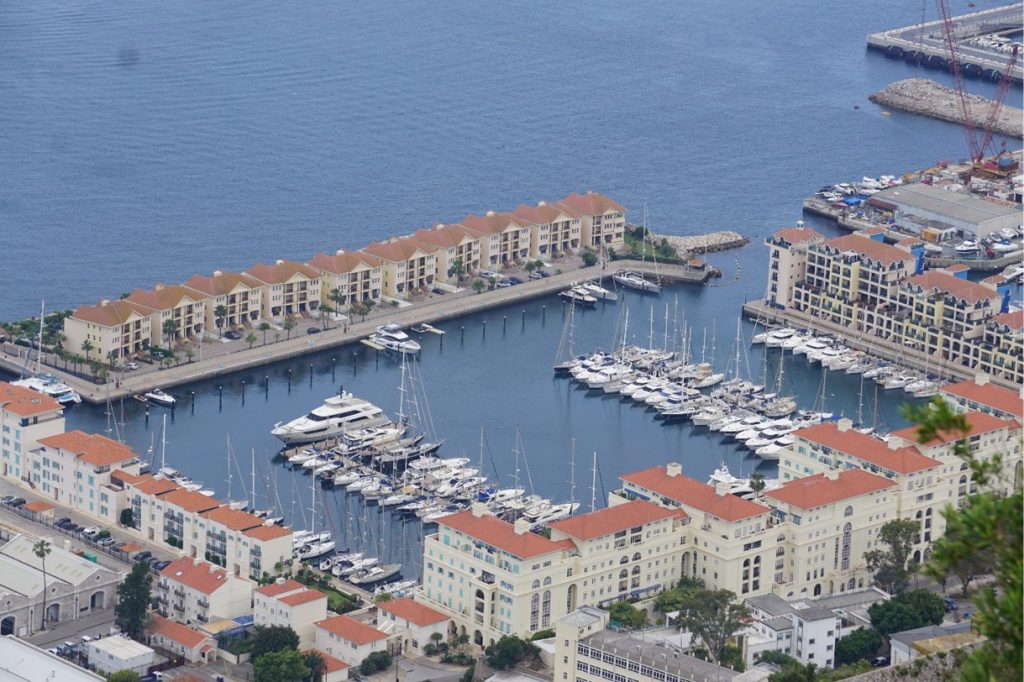
Queens Way Marina
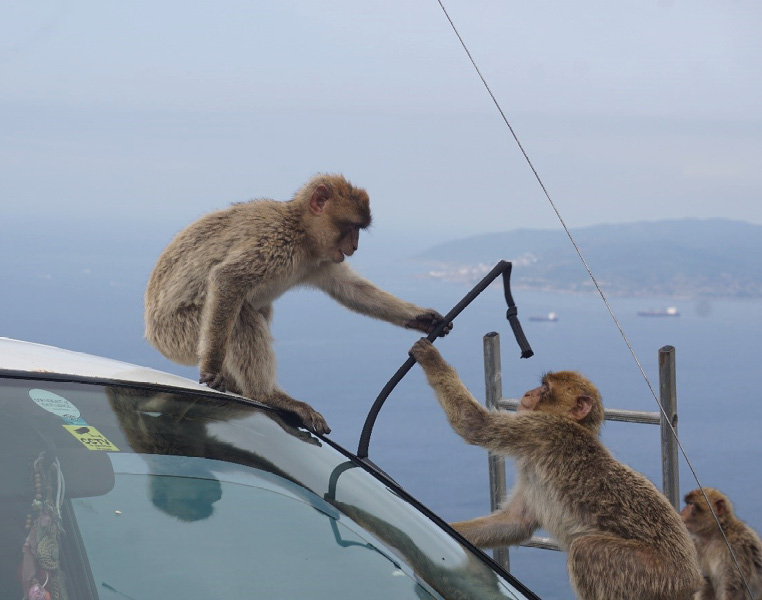
The monkeys on Gibraltar are adept at removing weatherstripping from cars.
Relations with Spain
Gibraltar has a Spanish problem, and has for centuries. Spain thinks it’s an affront to have a British colony on its doorstep. Never mind that Spain keeps similarly tiny “enclaves” on the northern Africa coast of Morocco, Ceuta, and Melilla, as well as the Canary Islands. Right next door with lovely local produce, Spain won’t export reliably. Somehow, the paperwork is never in order, so vegetable trucks sit on the side of the road for up to a week, their cargo rotting.
Consequentially, Gibraltar orders all its fresh produce from Holland. Dutch paperwork is perfect, and those trucks are not delayed. Efforts to build a containership import business similarly foundered.
Spain would not permit the trucks full of offloaded containers to cross the border, which is just 100 yards beyond Gilbratar’s airport runway with just one road in and out.
In addition, problems that existed pre-Brexit and pre-COVID have gotten worse. The local grocery, Morrison’s, is about 60 percent stocked. Entire aisles of refrigerated shelving are empty with labels of what should be there marked “out of stock.” The staff doesn’t have any idea when a soughtafter item will appear. You want European boat parts? Order them from America. A recently published cruising guide from Imray in England? Local chandleries have ordered it, but don’t know when the book will be in stock because the publisher isn’t sure how to mail it. The publisher’s representative tells us the mail will deliver the book for a reasonable fee and places the order. She calls back after discovering delivery time will be somewhere between a week and 30 days. We cancel our order.
Fun on the Rock
We thoroughly enjoy our visit, in spite of the difficulties we encounter. People are friendly, the Brits appear relaxed. We’re amazed by the number of children. We can’t go down a street without dodging one or more strollers. For the most part, we bike around town.
The official tour highlights are on top of the rock. Our guide shows us Saint Michael’s Cave, in happier times a per- formance space with spectacular lighting; the “wild” Barbary macaque monkeys begging for food; and a few of the 34 miles of tunnels the British military dug over 200 years — on a pen- insula of only 2.6 square miles.
Posidonia Prairies, Balearic Islands
Departing Gibraltar with an overnight stop in La Linea to check back into the EU, we plan a 230-nautical-mile trip to Cartagena, Spain, using Navily. This wonderful European app rates anchorages by protection from forecast wind and swells on a given date and time, as well as by user reviews.
As the intervening anchorages are poor for the forecasted weather, we motor-sail overnight and then pick up a free mooring in a beautiful marine reserve, Calle Cerrada on Cabo Tinoso, just west of Cartagena. It is so lovely we stay three nights.
We sail overnight to the Balearic Islands. Upon arrival, our primary concern is not to anchor on the Posidonia. Posidonia oceanica is a seagrass unique to the Mediterranean, highly prized by the local population and practically pervasive in the anchorages. There is one 100,000-year-old colony south of Ibiza measuring five miles across. The grass cleans the water, contributing to great clarity, and provides habitat for a wonderful range of fish.
Constantina of the “Posidonia police” visits our boat. She checks our anchor, and, thankfully, we pass — police can levy fines up to 1,000 euros for letting one’s anchor or chain touch the seagrass.
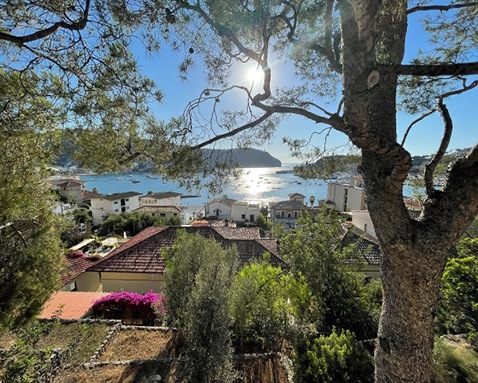
Puerto de Soller
Puerto de Soller
After six glorious weeks touring Formentera, Ibiza, and now Mallorca, we motor-sail from Port Andratx to Soller. The weather intrudes on our plans. While most of the mistrals’ winds come down on the French side of the Pyrenees, some divert to the west. Mistrals are difficult to forecast with significant variation in timing, intensity, wind direction, and exact area impacted.
Generally, Soller is a great harbor to shelter. Only 100 nautical miles from the Spanish mainland, Soller offers the shortest sail and is well protected from the forecasted northeast winds. Indeed, protection is great from all wind angles except the northeast and north where the harbor opens to the sea.
We enjoy a long afternoon snorkel in the 89-degree heat, followed by dinner ashore. While waiting for the check at a harborside café, we review the Windy weather forecast once more. The relative strength of the wind coming down the eastern side of the Pyrenees has increased, driving the wind lull, created by the converging winds, 40 nautical miles eastward. This shift changes the Soller wind direction to northwest by tomorrow morning. The waves are now forecast to aim directly into the harbor and build to 7 feet!
Night Sail in a Gale
There are enough stories of dragging anchors and colliding boats in Soller that we don’t want to stay. We rush back aboard and set sail to Port Andratx in the growing dusk. Tonight’s forecast is 15 gusting to 20 knots from behind, permitting an excellent, comfortable sail. Having seen Port Andratx, we are confident we can anchor just outside the breakwater with protection from tonight’s northeast wind, so our predicted arrival time of 1:30 a.m. is fine.
We clear the harbor and find that a full main is far too much. We take in two reefs and set the jib to balance the helm. Our desired course is dead downwind — not ideal for gusty winds and building 4-foot seas. Occasionally Moon Shadow wants to round up. We decide to jibe downwind a few miles out to sea where the cliffs will have less impact on the wind and waves.
Harnesses deployed and clipped to the boat, we are set for a fast, comfortable sail. Then we go faster. Moon Shadow is now sailing steadily at 10-plus knots with faster bursts. The wind gradually climbs to 32–35 knots, gusting to 38 apparent. Moon Shadow surfs at 13-plus knots. A few waves board the back of the boat, wetting our feet. We lock the lower hatch board into place. Spray now soaks us all over. I put on a fleece to stay warm. After we surf down one wave at 13.9 knots, we decide to wait for a lull and take in a third reef even though we’re just a few miles from jibing into the lee of the island.
Leisure furl reefing is a synchrony of motion in which every step, done perfectly, yields a smooth-as-silk maneuver that looks easy and works perfectly. First, we lock the jammer for our jib sheet and clear it off the port winch. We then raise the main’s topping lift to the 87-degree reefing position by aligning a mark on the topping lift with tape in the cockpit.
If the furling angle is off, the main jams when the luff tape hits the mast or rips when it rolls too far aft. Next, we luff the main and then simultaneously ease the main halyard and tighten the furling line on their respective electric winches. We can stop the reef at any of our six full mainsail battens, which help maintain foot tension.
Sailing across the Atlantic with our offshore crew, three of us can perform this maneuver downwind by hand-steering, centering the main to reduce pressure, and raising the boom a few extra degrees to accommodate the remaining leach pressure, with one person at the mast monitoring the furling angle. With two of us operating in 6-plus-foot seas at midnight under a cloudy, moonless sky, we turn on the motor and head up into a tight reach to reef while luffing the main. This yields intense salt spray all over the boat and too much noise for us to hear each other — but no accidental jibes and no worries about the furling angle.
Now we are traveling at a comfortable 8 to 9 knots. Our original plan was to sail once again between the islands of Sa Dragonara and Mallorca. However, we remember the 1-knot northerly current that boosted our speed. How would it react to a strong opposing wind? The dredging ship ahead of us goes outside. We find the answer by greatly enlarging the electronic Navionics chart which reveals this message: “Quite often strong cross sea, and chaotic waves. And with mistral over France, you better go back and stay on the west coast.” (The worst aspect of Navionics is that you can miss important information such as this unless you zoom in on the charts.) We go around the island, adding another hour. We sail for Badalona the next day after the mistral clears.
Back in the U.S., the Nautor’s Swan boatyard replaces our jib track, creates a new stainless gooseneck fitting, and myriad other small projects. They too are a great yard. We are so appreciative of the workmen we have found. ■
Jil Westcott, a retired computer scientist, began sailing as a child at summer camp, raced Sunfish in high school, and continued racing dinghies at MIT. Jil and her husband, co-skipper John Bell, have sailed many miles on a series of vessels, from Solings in Boston Harbor to their current Aerodyne 47 Moon Shadow. Jil enjoyed skippering “ladies’ cruises” from Rhode Island to Maine, which often included children. In 2017, Jil and John acquired Moon Shadow and spent the next few months doing a complete refit for the 2018 Newport Bermuda Race, where Jil skippered the boat. In 2019 they sailed Moon Shadow Trans-Atlantic and now cruise seasonally in the Mediterranean. In addition to being a skilled celestial navigator, certified American Sailing Association instructor, and charter captain for delivery and instruction, Jil has a 50-ton merchant mariner license.
With thanks to the Cruising Club of America in whose magazine, Voyages Issue 65, this article first appeared, and Voyages editors Amelia & Robert Green.
The Cruising Club of America (CCA) is a collection of 1,400 ocean sailors with extensive offshore seamanship, command experience, and a shared passion for making adventurous use of the seas. Their experiences and expertise make them, collectively, one of the most reliable sources of information on offshore sailing. Visit cruisingclub.org to learn more.



